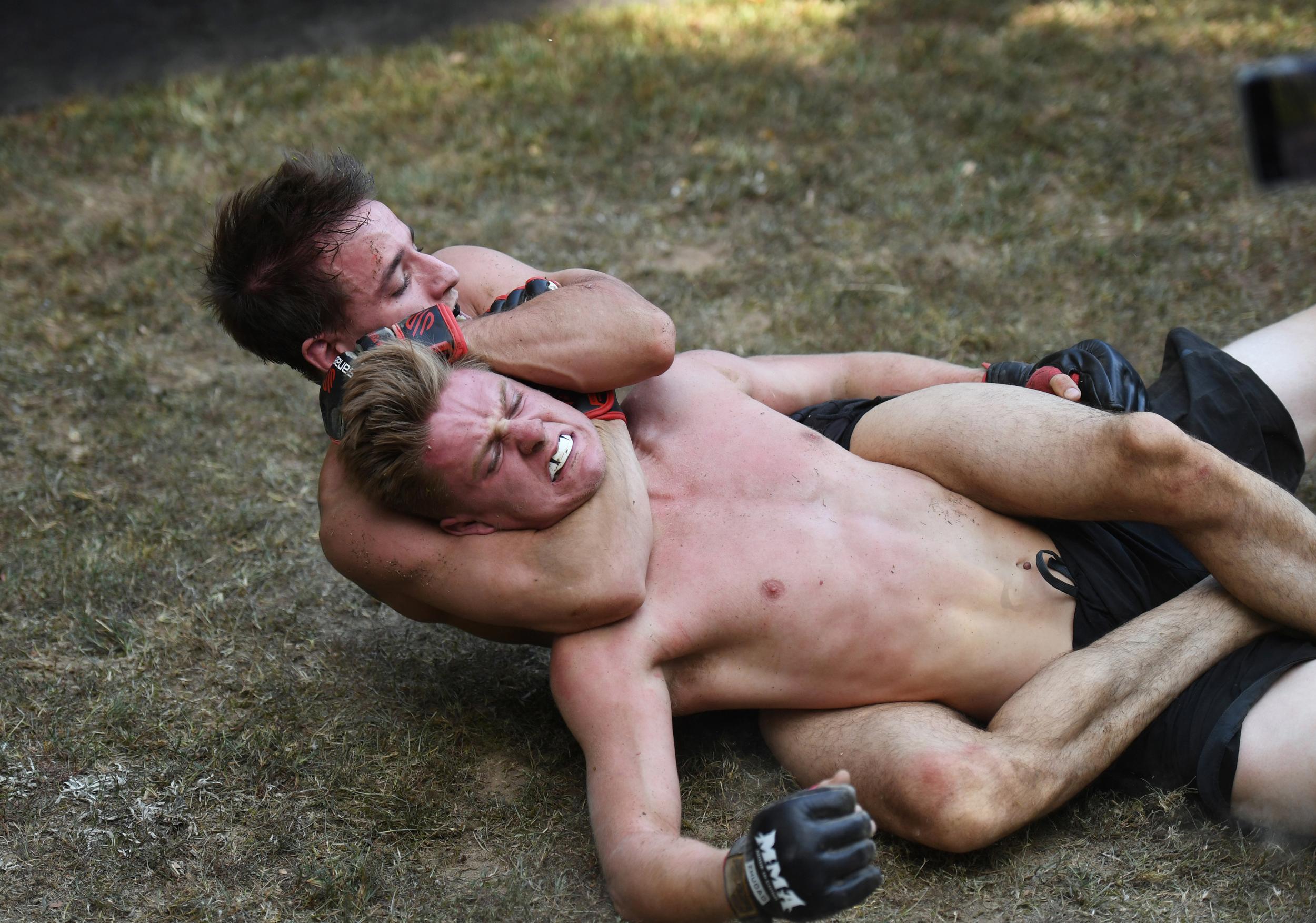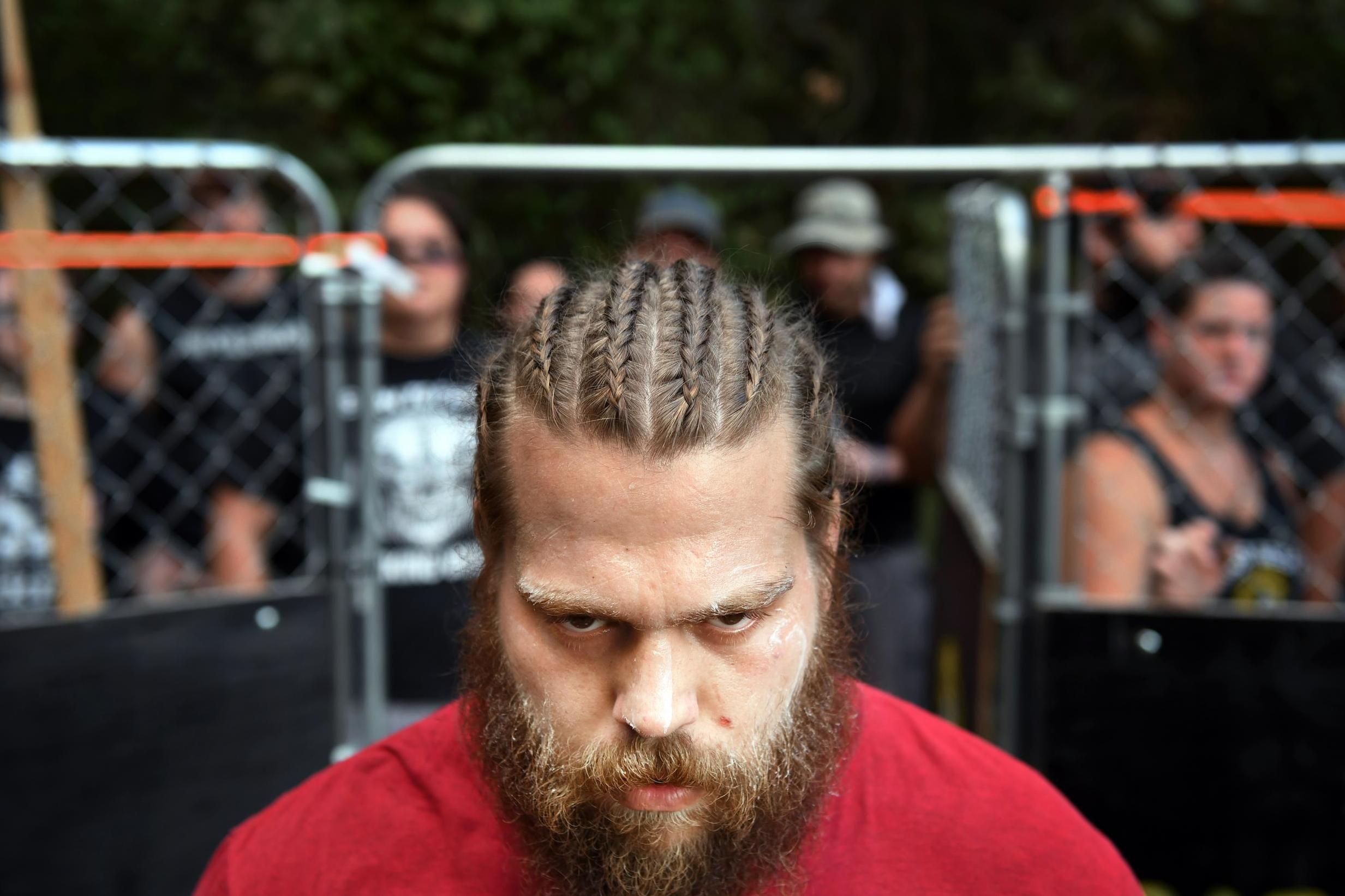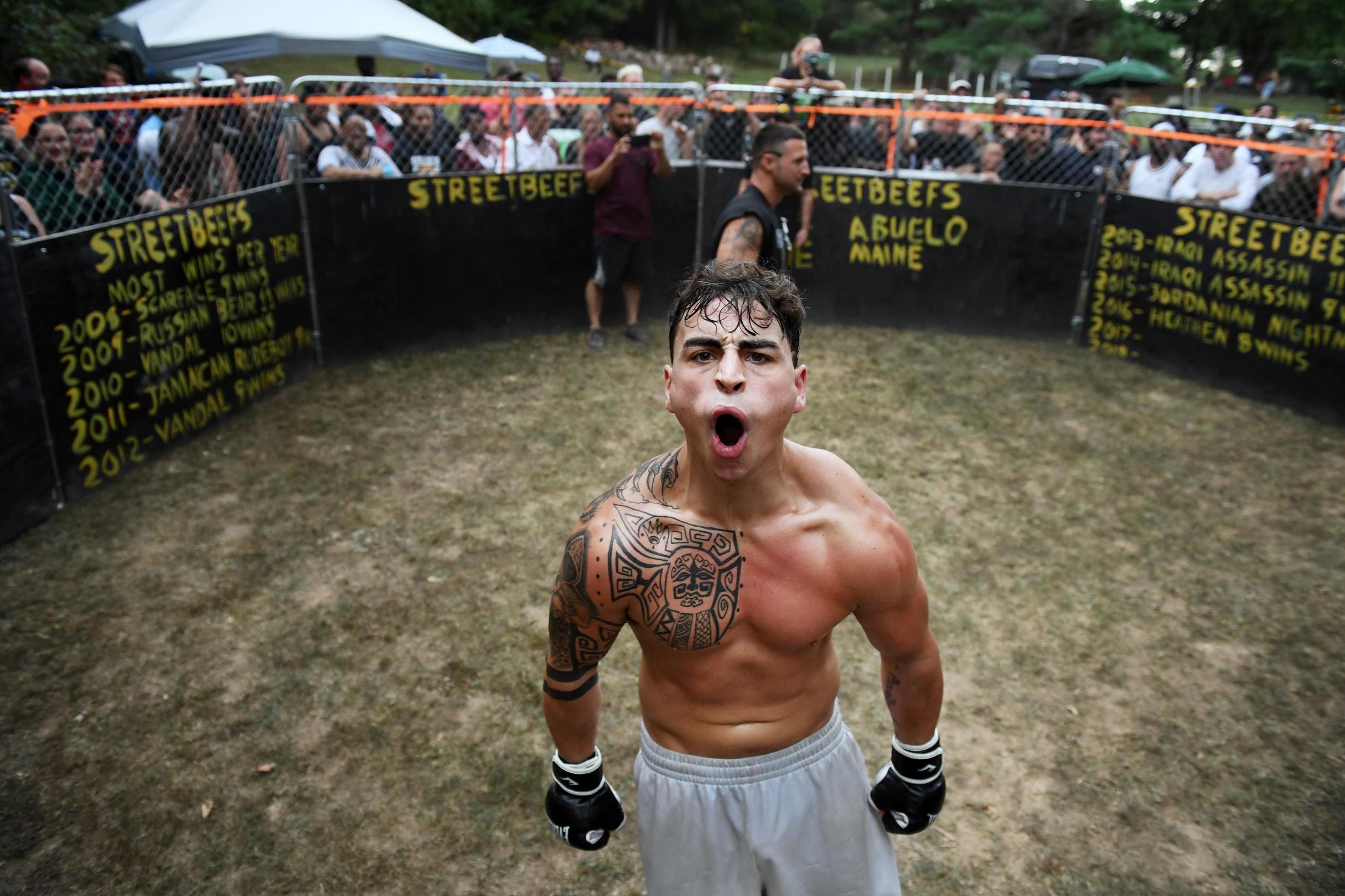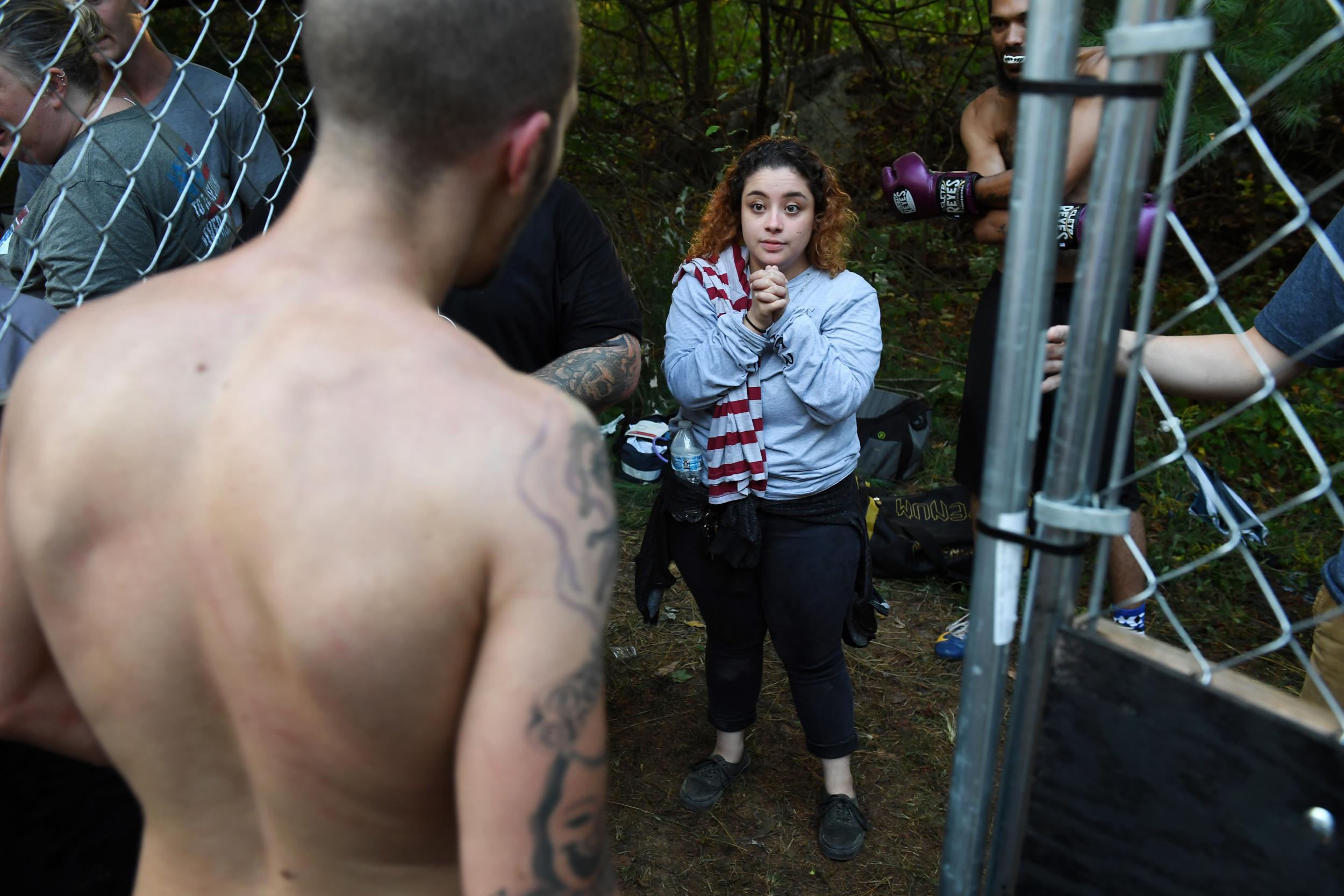Are backyard brawls a solution to gun violence?
Inside the fight club that lets two people with a grudge pummel each other to resolve their grievances

Your support helps us to tell the story
From reproductive rights to climate change to Big Tech, The Independent is on the ground when the story is developing. Whether it's investigating the financials of Elon Musk's pro-Trump PAC or producing our latest documentary, 'The A Word', which shines a light on the American women fighting for reproductive rights, we know how important it is to parse out the facts from the messaging.
At such a critical moment in US history, we need reporters on the ground. Your donation allows us to keep sending journalists to speak to both sides of the story.
The Independent is trusted by Americans across the entire political spectrum. And unlike many other quality news outlets, we choose not to lock Americans out of our reporting and analysis with paywalls. We believe quality journalism should be available to everyone, paid for by those who can afford it.
Your support makes all the difference.Jeff Spille doesn’t want to talk about what started the beef.
“I get it,” I tell him.
I know what happened between him and Charles Surber, and it’s personal, it’s painful.
It also doesn’t matter what caused the two friends to become enemies. What matters is that for eight years, anger boiled, then simmered, then stuck in that impossible-to scrub-off way inside of Spille. He carried it with him wherever he went.
“It was always in the back of my mind,” he says. “It was just eating away at me.”
Let’s just call what happened “the incident”. Before “the incident,” he and Surber graduated from the same high school, shared the same circle of friends and saw each other often, sometimes intentionally, sometimes not. Spille would walk into a bar and there would be Surber. Surber would walk into Walmart and there would be Spille.
After “the incident”, Spille says the two never ran into each other. He’s not sure how that’s even possible in a small town like Winchester, Virginia, but he knows himself well enough to describe that as a good thing.
“I was ready to fight at any moment or do whatever it took,” he says.

Many smart, much-debated ideas exist on how we should address the nation’s gun violence problem. They can be found in academic studies, and in state and federal legislation that has passed and failed. They can be found on the signs of March for Our Lives protesters and on the lips of people who have lost children, parents and parts of their own bodies to gunshot blasts.
They can also be found on a grassy lot located more than an hour and a half from Washington. If you arrive at the right time on the right weekend each month, you’ll find a group of people who say they have found a way to fight gun violence that has nothing to do with studies, laws or protests.
Their solution, they will tell you, is much simpler: let two people with a grudge pummel each other.
“I know that it probably sounds ridiculous from the outside,” Chris Wilmore says. “It’s hard to explain. But I can tell you that I have solved beefs with guys I hated before I fought them, and now we talk regularly.”
Wilmore, who is called “Scarface” and sometimes just “Face”, created the fight club “Streetbeefs” in his Harrisonburg backyard in 2008. His goal at that time was to provide a safe place for people in his community to settle disputes. Like him, many of the club’s first members had criminal records and were aware of what could happen if they took their fights to the streets. The club’s motto is “Guns down, Gloves up”.

“We don’t want anyone dying and we don’t want anyone going to jail,” Wilmore says. “What we do is make them give their word that if this fight doesn’t solve it, they have to come back.”
He says he has seen men fight over borrowed money that wasn’t paid back, a lent car that was returned damaged, a woman, a tree stand, a tip given to a probation officer about someone’s marijuana habit. One dispute got so out of hand, he says, the men tried to run each other off the road.
“I was stabbed in my throat in a street dispute years ago,” he says. “You may think your dispute is petty. I’ve seen people die over petty.”
In recent years, the club has grown in popularity. Videos of its fights are now watched by people in other states and countries, and they sometimes come to participate.
On a recent weekend, men travelled from California, Oklahoma and the Netherlands to gather in the bare-bones backyard of one of Wilmore’s friends. There, they stepped into a ring made from a chain-link fence and black-painted plywood bearing the scrawled names of other fighters: Iraqi Assassin, Russian Bear, Vandal.
Most of the people who fought that day simply wanted to test their skills.
Spille and Surber were there for another reason. They had come to settle their beef.
Spille and Surber had both recently started going to Neutral Corner Boxing, which was owned by a mutual friend, and Spille realised that made it more likely they would run into each other. He figured it was finally time to address what they hadn’t. Through their friend, he invited Surber to fight him at the Streetbeefs event.
Each fight consists of three, two-minute rounds. That’s six minutes of contact. It seemed a small amount of time to accomplish something as big as extinguishing eight years of anger.
I had my doubts. I shared them with Wilmore a few days before the fight. He told me that 90 per cent of the beef fights he has seen haven’t gone beyond the ring. The club’s success rate is also skewed by the few women who have fought. “Those are the ones that for some reason never get solved,” Wilmore says.
The club, he points out, has also settled beefs that never turned into fights.

“So, you’re also part therapist?” I ask him.
“I guess, a ghetto therapist,” he says. “I think it’s just cause I can relate to them. A lot of these guys come from broken homes, and feel like no one is there for them.”
On the day that Spille and Surber step into the ring, Wilmore stands between them. The men are an even match, with both measuring 6 feet tall and about 190 pounds. For their fighting names, they chose “Caterpillar” and “Chuck D”.
“When this is over, it’s over, man,” Wilmore tells them. “No matter what happens, you leave this s**t here, in the yard, all right?”
The men nod and then tap gloves.
Surber, who is 36, says he didn’t want to fight, but he agreed because “I did him wrong”.
“I understood his side of it,” Surber says. “It’s about forgiveness. Sometimes it’s a little bit easier to forgive someone when you get to punch him in the face.”
Spille had requested that they wear mixed martial arts gloves, which can do more damage. Surber insisted they use boxing gloves – and once they start fighting, he is glad he did.
By the end of the third round, he has a broken blood vessel in one eye and a couple of bumps forming on his brow. He notices that Spille doesn’t seem to have any marks on him.

Spille, who is 35, threw several missed punches and hurt his shoulder enough that the pain would last for a week. But that day, he later recalls, he “felt great”.
After the fight, he went and bought a six-pack of beer, and invited Surber to join him for one.
“We actually sat down and talked together for the first time in eight years,” Spille tells me when I call him a few weeks later. I wanted to give him and Surber some time before checking on whether the fight had really settled anything.
“It’s over and done,” Spille says. “I was in a really bad spot for a long time. It took a long time for me to get over it, and honestly, I never fully got over it until that day.”
He hadn’t followed Streetbeefs much before his own fight, but he says he now believes in what the group is trying to do. He has a concealed-weapons permit and estimates he owns about 15 guns. He says many of the people he knows hunt and own weapons, too.
“I think what Chris started is an outlet for a lot of people,” he says. “Even people who aren’t beefin’, they might have other demons they are fighting in their heads and they’re letting them loose in the ring.”
Surber says he felt a genuine “connection” with Spille after their match ended. No winners are declared in beef fights, so that no one will feel as if they lost.
“He looked me right in my eyes and I looked him in his, and the negativity was out of there,” Surber says. “That was on his part. He was actually able to forgive me. That’s pretty cool. It felt nice not to have to look over my shoulder.”
Both men say they don’t expect they’ll ever be good friends again. They also don’t expect to feel any urge to fight if they happen to walk into the same bar, store or gym on the same day.
© The Washington Post
Join our commenting forum
Join thought-provoking conversations, follow other Independent readers and see their replies
Comments